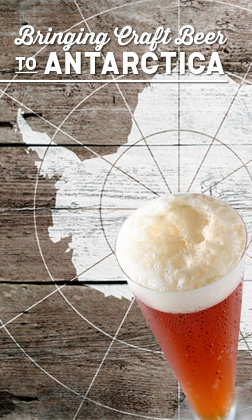At the bottom of the planet sits Antarctica, a continent covered in ice. Home to penguins, leopard seals and breathtaking beauty, it is the only continent on Earth without a native human population. During its summer season, Antarctica plays host to less than 5,000 people, almost all of whom are scientific researchers and their support staff. Tourists are known to visit every so often, but usually fail to see the full scope of its 5.4 million square miles. But, is there craft beer in Antarctica?
Antarctica is the highest, driest, windiest, emptiest and coldest place on earth—and naturally there are no breweries contained within its borders—so beer must travel to Antarctica. The dozen or so countries that have research stations throughout the continent usually source their beer from home, giving the staff a taste of something familiar, and he U.S. is no exception. In the past, large brands or international brands have been shipped down, but these days craft beer is making the trek.
Before Jason Kirk took the job of beverage and retail manager for the United States Antarctic Program, he spent a lot of time in Colorado and also managed a bar, where he became very familiar with craft beer. In his current position, Kirk is responsible for every bit of food and drink that is sent to the white continent for the U.S. researchers stationed there. When the time came to order beer for a new season—something to help the 1,700 or so Americans stationed throughout three bases—he reached out to Boulder’s Avery Brewing Co. to see what they could do for him.
“He came by the brewery and we talked about what they needed (mostly cans) and what we could do to set them up,” said Avery’s national sales manager Ted Whitney. “We also made Jason try pretty much every beer on tap in the tasting room that day, just to make sure he was selecting the right flavors for his crew.”
After some back and forth, the brewery wound up shipping 20 palates of hoppy Colorado goodness to Antarctica. Kirk reached out to Oskar Blues as well, and they will also be sending beer to the deep freeze. After leaving Colorado, the beer will be boarded onto shipping containers where it will first go to New Zealand, and then make the trip to Antarctica. It’s a process that takes several weeks.
Kirk has imported other craft beers in recent years, including offerings from Samuel Adams, Sierra Nevada Brewing Co. and New Belgium Brewing Co. He said, however, that he wants to focus on bringing canned craft beers to Antarctica to cut down on shipping weight. Since there are no processing facilities on the continent, and because environmental maintenance is paramount, every item that comes into the base, must be returned.
“Cans certainly help out with that,” said Kirk. “I’m going to start looking at more canned options and see what’s a good value.”
As word of the new beers spread, Kirk says the crew became excited. Many stationed there are from Colorado and familiar with the brands and styles. Others were grateful for heartier beers that can stand-up to the cold and their carb heavy diet—a lot of pasta and stir frys—that help keep nutrition and spirits strong.
Kirk, in a phone interview in early February from the McMurdo base, was excited about the beer additions and said that some folks had talked about trying their hand at homebrewing, if they could get the ingredients (water obviously won’t be a problem) and the right kit.
If they do wind up brewing, they won’t be the first to use water from Antarctica. Several years ago while watching a cartoon movie about dinosaurs with his son, Sam Calagione of Dogfish Head Craft Brewed Ales got the idea to brew a beer with ingredients from all seven continents. While no one would have been surprised if the adventurous brewer had decided to go with plankton, he instead went with melted ice for his Antarctic ingredient.
“When we brew Pangaea, we work with a U.S. military/research station on Antarctica,” said Calagione. “They send us a couple of five gallon buckets of Antarctic water and each 750 ml bottle of Pangaea is pretty much guaranteed of at least a few molecules of Antarctic water.”
The 2013 summer season is quickly coming to a close in Antarctica, and Kirk says that the majority of workers will be gone by March. When the crews begin arriving in earnest again this October they’ll have a good taste of home waiting for them.
CraftBeer.com is fully dedicated to small and independent U.S. breweries. We are published by the Brewers Association, the not-for-profit trade group dedicated to promoting and protecting America’s small and independent craft brewers. Stories and opinions shared on CraftBeer.com do not imply endorsement by or positions taken by the Brewers Association or its members.


Share Post